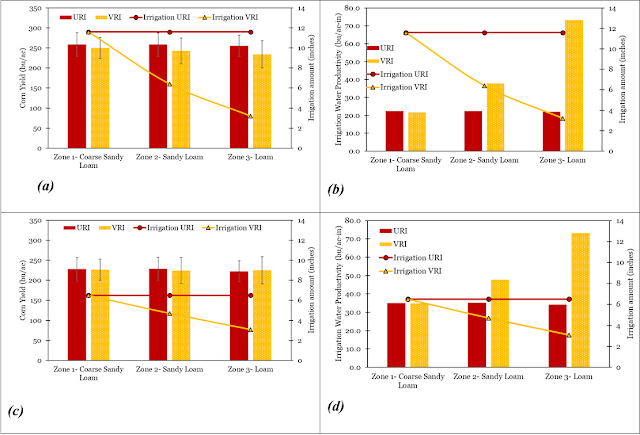A recent on-farm study conducted in the Central Sands region of Minnesota shows that variable rate irrigation technology could help save farmers water and reduce irrigation-induced nutrient loss to the environment without impacting farm profitability.
Minnesota’s Central Sands region
More than 25% of groundwater in Minnesota is pumped for irrigating crops. This makes irrigation the second-largest user of groundwater in the state. Minnesota has over 600,000 acres of irrigated cropland, and many of these irrigated acres are in the state’s Central Sands region. The coarse textured or sandy nature of the region’s soils means that they do not hold large quantities of water and have a rapid drainage rate to groundwater compared to high clay soils.These soils present challenges in agricultural irrigation and nutrient management. It takes less precipitation to saturate these soils, and they hold less plant-available water than loamy soils. Low organic matter levels also mean that these soils provide less nitrogen, and higher nitrogen fertilizer rates are required. Attaining economically viable yields requires careful irrigation management and well-timed fertilizer applications.
Groundwater issues
Two critical challenges in agricultural watershed management in Minnesota are:- Groundwater quality: Water percolates quickly through the soil profile in coarse-textured soils, moving some agricultural nutrients from applied fertilizers below the root zone. Leached nitrogen poses environmental, human health, and economic risks to communities that use groundwater for drinking. The nutrient loss also represents a financial loss to the farmer as some of the nutrients they paid for are lost.
- Water availability: High groundwater withdrawals during the crop growing season can temporarily reduce groundwater discharge into nearby streams and lakes, impacting aquatic life and recreational activities on waterways and leading to water supply shortages for nearby private and municipal wells. In the dry years that Minnesota has experienced in the last three years, ground and surface water availability is a huge concern in some irrigated parts of the state.
On-farm variable rate irrigation study
A meaningful way to address groundwater issues is by implementing proven advanced irrigation management techniques and technologies such as variable rate irrigation (VRI). With funding from the AGRI Sustainable Agriculture Demonstration Grant from the Minnesota Department of Agriculture (MDA), we conducted an on-farm research project in Stearns County, Minnesota during the 2021 and 2022 growing seasons to evaluate the ability of precision irrigation technology to address both groundwater quality and water quantity issues.

|
| Figure 2. Soil moisture sensor
installed in the field. |
By addressing in-field variability using VRI technology, we can optimize irrigation, maximize crop growth, and minimize negative environmental consequences. For this project, irrigation management zones for VRI management were created based on soil electrical conductivity (EC), soil type, and elevation. Many studies have shown that EC is related to soil properties and crop yield potential and could be used for site-specific management in precision agriculture. An irrigation rate of 100% was applied across the entire URI plots regardless of the soil variability (see figure 1 below). Irrigation events were scheduled based on the soil moisture sensors (Figure 2) installed in each treatment. When sensor-measured water content in the lowest EC (zone 1) locations (sandy soils and low water holding capacity) dropped close to 50% of available water holding capacity, irrigation was triggered. In each irrigation event, the irrigation amount was based on the water holding capacity as well as irrigation system capacity.
2021 results
2022 results
Conclusion
| URI
Zone 1 |
URI
Zone 2 |
URI
Zone 3 |
Average | VRI
Zone 1 |
VRI
Zone 1 |
VRI
Zone 1 |
Average | |
|---|---|---|---|---|---|---|---|---|
| Irrigation (in) | 11.6 | 11.6 | 11.6 | 11.6 | 11.6 | 6.4 | 3.2 | 7.0 |
| Yield (bu/ac) | 258.9 | 258.8 | 255.5 | 257.7 | 250.2 | 242.7 | 234.2 | 242.4 |
| Irrigation water productivity
(bu/ac-in) |
22.3 | 22.3 | 22.0 | 22.2 | 21.6 | 37.9 | 73.2 | 34.6 |
| *Gross income ($) | $1,295 | $1,294 | $1,278 | $1,289 | $1,251 | $1,214 | $1,171 | $1,212 |
| *Net income | $1,109 | $1,108 | $1,092 | $1,103 | $1,065 | $1,111 | $1,120 | $1,100 |
*Assumes corn price of $5/bu and irrigation cost of $16/ac-in; Net income = return on irrigation investment.
Table 2. Seasonal irrigation amounts (inches) applied, yields (bu/acre), Irrigation water productivity (IWP), gross income ($) and net income ($) in each irrigation treatment and zone in 2022.| URI
Zone 1 |
URI
Zone 2 |
URI
Zone 3 |
Average | VRI
Zone 1 |
VRI
Zone 1 |
VRI
Zone 1 |
Average | |
|---|---|---|---|---|---|---|---|---|
| Irrigation (in) | 6.5 | 6.5 | 6.5 | 6.5 | 6.5 | 4.7 | 3.1 | 4.8 |
| Yield (bu/ac) | 227.8 | 228.7 | 222.4 | 226.3 | 226.5 | 224.4 | 225.1 | 225.3 |
| Irrigation water productivity
(bu/ac-in) |
35.1 | 35.2 | 34.2 | 34.8 | 34.8 | 47.7 | 73.1 | 47.3 |
| *Gross income ($) | $1,139 | $1,144 | $1,112 | $1,358 | $1,132 | $1,122 | $1,125 | $1,352 |
| *Net income ($) | $1,035 | $1,040 | $1,008 | $1,254 | $1,028 | $1,047 | $1,076 | $1,276 |
*Assumes corn price of $5/bu and irrigation cost of $16/ac-in; Net income = return on irrigation investment.




![[Technology Corner] Autonomy & Robotics Take Center Stage](https://www.precisionfarmingdealer.com/ext/resources/2026/01/12/Autonomy--Robotics-Take-Center-Stage.webp?height=290&t=1768253759&width=400)


